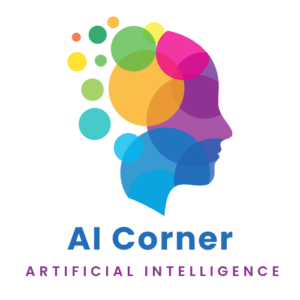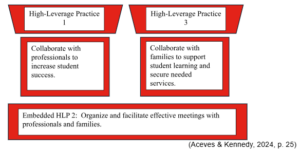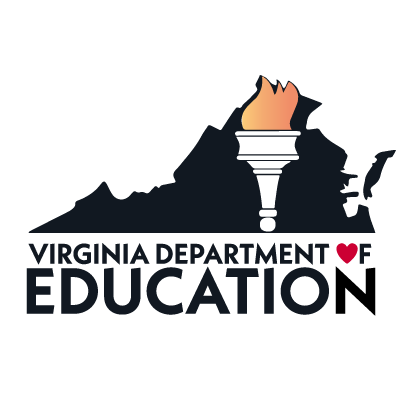Family Collaboration in Special Education: An Underrated Key to Success
BethAnne Klaver, M.Ed and Courtney Fuller, Ed.S, CCC-SLP
![]()
_________________________

* AI is AT, but AT is not always AI
by LaShauna M. Britt
Analogies like, “AI is AT but AT is not always AI,” are a nice way to compare two things for explanation or clarification. However, we know that figures of speech can confuse many. A colleague and I discussed this analogy, and we agreed that Artificial Intelligence (AI) and Assistive Technology (AT) both help individuals gain access, specifically in the classroom. Additionally, this access cannot be achieved without the collaboration of all stakeholders involved in a student’s life with disabilities. This conclusion brings us back to High Leverage Practices (HLPs) 1: Collaboration and 19: Use Assistive and Instructional Technologies, because both are needed to help one gain access in all meanings of the word ‘access’.
The integration of AI, AT, and collaborative practices in special education can enhance the delivery of HLPs and specially designed instruction (SDI) for students with disabilities. AI tools such as adaptive learning platforms, predictive analytics, and speech-to-text software help teachers tailor instruction based on real-time data and student progress. AI can analyze patterns in student performance and suggest instructional strategies aligned with HLPs, such as formative assessment, explicit instruction, and feedback.
Collaboration among general educators, special educators, related service providers, and families is essential for successful integration. Teams collaborate to select and evaluate the use of AI and AT tools, ensuring they align with instructional goals and meet the needs of students. Through collaborative planning, educators embed HLPs, such as collaboration, cognitive and metacognitive strategies, and social-emotional support, within daily instruction.
Students benefit most when all stakeholders are on the same page and use AI and AT that support SDI that is measurable, intentional, and individualized. For example, a student with a reading disability may receive SDI in decoding strategies, supported by an AI-driven phonics app and AT such as text-to-speech. The teacher monitors progress, adjusts instruction, and collaborates with the team to refine supports. Assistive Technology, ranging from low-tech visual aids to high-tech communication devices, plays a critical role in removing barriers to learning. AT allows students to access curriculum, express understanding, and engage with content in ways that align with their strengths and needs. When implemented effectively, AT supports SDI by providing individualized tools that directly address IEP goals and state standards.
The lens through which you view instruction for students with disabilities is the lens that helps you, as an educator, access your knowledge and understanding when it comes to supporting these students. In the Resources section below, there are a few resources regarding the use of AI and AT or AT and AI, depending on which comes first in your lens. Although Universal Design for Learning was not explicitly mentioned in this blurb, it is a framework used to help individuals gain access and reduce barriers. You can find additional information about this framework in the resources listed below.
Resources
- Website: Virginia Department of Education: Assistive Technology. This website gives an overview of assistive Technology in Virginia.
- Website: Assistive Technology Network. This is a website that addresses the priorities of the Virginia Department of Education concerning the coordination, implementation, and dissemination of information regarding Assistive Technology.
- Website/Video: This video, created by The Council for Exceptional Children (CEC), explains HLP 19: Use Assistive and Instructional Technologies.
- Website: Universal Design for Learning (UDL)
________________________________________________

Leveraging Collaboration to Improve Outcomes for Students with Disabilities
by Cathy Buyrn M.E
The July 2025 edition of the Link Lines Administrators’ Corner, Integrating High-Leverage Practices for Students with Disabilities, connected the High-Leverage Practice (HLP) domains (i.e., Collaboration, Data-Driven Planning, Instruction in Behavior and Academics, Intensify and Intervene as Needed) offered by The Council for Exceptional Children (CEC) in collaboration with the Collaboration for Effective Educator Development, Accountability, and Reform (CEEDAR) Center at the University of Florida. The September 2025 edition, Building Data Literacy & Progress Monitoring Skills, focused on the Data-Driven Planning domain. In this edition of Link Lines, the collaboration domain, pillar, and embedded practice (See Figure 1) will be explored and connected to all aspects of improving outcomes for students with disabilities. While each of the HLP domains are distinct, they work in concert with one another to establish high-quality learning conditions focused on meeting the individual needs of students with disabilities.
Figure 1
High-Leverage Practices Collaboration Domain

The common saying “it takes a village to raise a child” (unknown origin) is true for all children. For students with disabilities, it is critical that all members of each student’s village engage in high-quality collaboration to ensure that skill gaps are closed and progress be achieved. School leaders charged with supervising special education should provide professional development and systems that support the collaborative skills of special educators and their general education partners. CEC and the CEEDAR Center have developed an HLP Professional Development Guide for School Leaders to support professional development efforts. Special education services are not disconnected from general education and general education delivery should be influenced by the individual needs of students outlined in their Individualized Education Programs (IEPs) (Individuals with Disabilities Act [IDEA], 2004). All service providers should be versed in identified effective collaboration behaviors.
- Sharing ideas
- Active listening
- Questioning
- Planning
- Problem solving
- Negotiating
(Aceves & Kennedy, 2024, p. 29)
Professionals who engage in effective collaboration behaviors are far more likely to be able to help students and families engage in these behaviors and build trust. Communicating with students and family members about challenges and vulnerabilities can result in emotional and defensive responses that can inhibit relationships, but trained professionals are prepared to navigate those challenges without jeopardizing student outcomes. School-based professionals need to be mindful of their own preconceived ideas and be open to the expertise that other professionals and families bring to the table. Students and families can utilize the resources on the I’m Determined website to self-advocate and consider Critical Decision Points (Virginia Department of Education, 2019) during their PreK-12 experience.
While the collaboration with students and families can be challenging, collaboration with other professionals can be just as daunting. The dynamics of professional relationships are often complicated by different levels of responsibility and beliefs. If school-based professionals do not address these complications effectively, it will be hard to collaborate with families and build trust. School leaders must assist professionals with balancing any challenges for those who share responsibilities for serving students with disabilities. If everyone in the student’s village works to actively listen to one another, trust one another, hold high expectations for each student, and focus on accomplishing learning goals (Aceves & Kennedy, 2024); skill gaps will be closed and students will make progress.
The embedded HLP, “organize and facilitate effective meetings with professionals and families” (Aceves & Kennedy, 20204, p. 29) in the collaboration domain represents formal meetings, but the day-to-day collaboration between those scheduled events is just as critical. If ongoing communication with professionals, students, and families has been productive, the formal meetings will be far more effective and a clear plan for comprehensive services will be achieved. School leaders who establish systems that facilitate effective collaboration will enjoy higher levels of family engagement and professional job satisfaction for educators.
The Lead IDEA Center has developed examples and tools that school leaders can use to improve the collaborative skills of special and general educators serving students with disabilities. Their Principal Navigator: Special Educator Retention resources offer support around common barriers to effective collaboration and job satisfaction. The top issues impacting special educator retention are:
- Role Ambiguity
- Feeling Isolated
- Untapped Expertise
- Overloaded and Overextended
- Differing Expectations: School and Home
- Feeling Unsupported
(Lead IDEA Center, 2025)
Effective school leaders can alleviate role ambiguity and feelings of isolation for special education teachers and the other professionals they collaborate with (i.e., general education teachers, related service providers, content specialists, administrators) by clarifying roles and promoting shared responsibility. The Lead IDEA Center (2025) provides a Clarifying Roles & Responsibilities Toolkit and a Shared Ownership & Collaboration Toolkit for addressing role ambiguity and isolation. When roles are clear and there is an understanding of shared ownership for student progress in the general education curriculum and with individual IEP goals, the expertise of all professionals can be leveraged to accomplish improved student outcomes and improve teacher efficacy. The Empower & Utilize Expertise Toolkit from the Lead IDEA Center (20205) provides administrators with strategies and tools for maximizing the use of the specialized knowledge and skills that special educators bring to the table.
Addressing role ambiguity, feelings of isolation, and untapped expertise sets the stage for effective professional collaboration between special education teachers and other professionals at the building level. School leaders need to keep in mind that the context and relationship dynamics are always in flux and will need to be tended to in an intentional and ongoing way. Leaders need to look for signs of overload, overextension, challenges navigating family to school relationships, and feelings of a lack of support for struggling special education teachers. The Lead IDEA Center (2025) offers additional toolkits for Balancing Workloads, Engaging Successfully with Students & Families, and Supporting & Empowering Novice Teachers.
It should come as no surprise to school leaders charged with supervising special education that the issues faced by special educators all pertain to collaboration challenges with professionals and families. The resources provided by the Lead IDEA Center will help school leaders develop supports and systems designed to navigate these challenges with real world scenarios and tools for building capacity. Effective and productive school villages thrive in environments where school leaders anticipate challenges and work with all stakeholders to improve outcomes for all students and build educator efficacy.
References
Aceves, T. C. & Kennedy, M. J. (Eds.). (2024). High-leverage practices for students with disabilities (2nd ed.). Council for Exceptional Children and CEEDAR Center.
Individuals with Disabilities Act, 20 U.S.C. § 1400 et seq. (2004). https://sites.ed.gov/idea/statute-chapter-33
Lead IDEA Center. (2025). Principal navigator: Special educator retention. Lead IDEA Center. https://lead-idea.org/navigator/retention
Virginia Department of Education. (2019). Critical decision points animated guides. https://www.imdetermined.org/tool/critical-decision-points/




